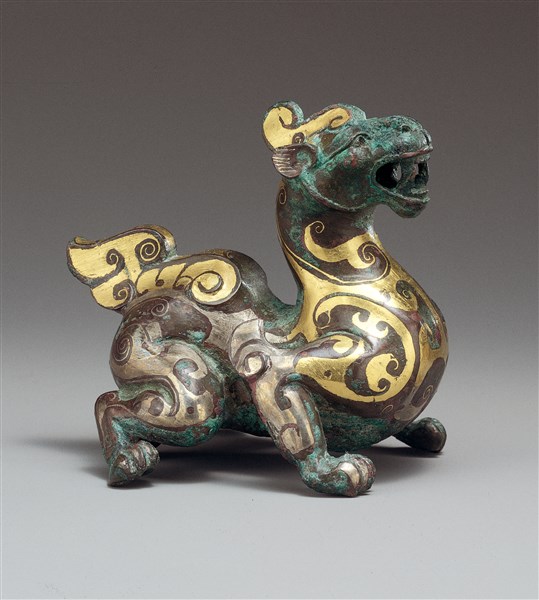Mythical Animal
- China
- China, Western Han period
- 2nd century B.C.
- Bronze with gold and silver foil inlays
- H-7 W-7.2
Catalogue Entry
The features of this small lively animal do not identify it with any natural species. It has a horse-like head with blunt muzzle, but sharp fangs. A single, curled crest and small alert ears sweep back from the top of its head. The creature stands on leonine paws, chest proudly thrust forward, front legs straight and taut, and hind legs bent as if ready to pounce. Comma-shaped excrescences, suggesting wing feathers, accent each elbow. Gold and silver inlays highlight the crest, ears, chest, body, tail, and legs. The eye sockets were once also inlaid. The figure is hollow, with an opening on the underside of its belly, probably left by the casting process.
It is unclear in what contexts such exquisitely decorated mythical creatures of this size and scale may have served. Imaginary creatures abound in late Eastern Zhou texts and religions, playing especially important roles in Daoist thought and the pursuit of immortality during the Qin and Han periods (see cat. nos. 108, 109). During these period, similarly scaled, fabulous and real animals were often made of jade and decorated bronze in groups, and may have been meant as the exotic inhabitants of miniature, three-dimensional models of the Isle of the Immortals where their owners hoped one day to dwell.1
JFS
1. So 1996, pp. 29-30.
Mythical Animal
This figure of a monster with glaring eyes fits in the palm. Gold cloud patterns roil over its back. Energy fills the whole body, which seems poised for action, ready to pounce upon a demon.
This body form, along with the sharp claws, powerful legs, collar-like ridge and furred ears, along with the characteristic wavy horns, resembles the lion-griffon of Persia. This guardian beast originated in Eurasia and became the mythical Bixie to form a pair with Tianlu in the Chinese lore.
